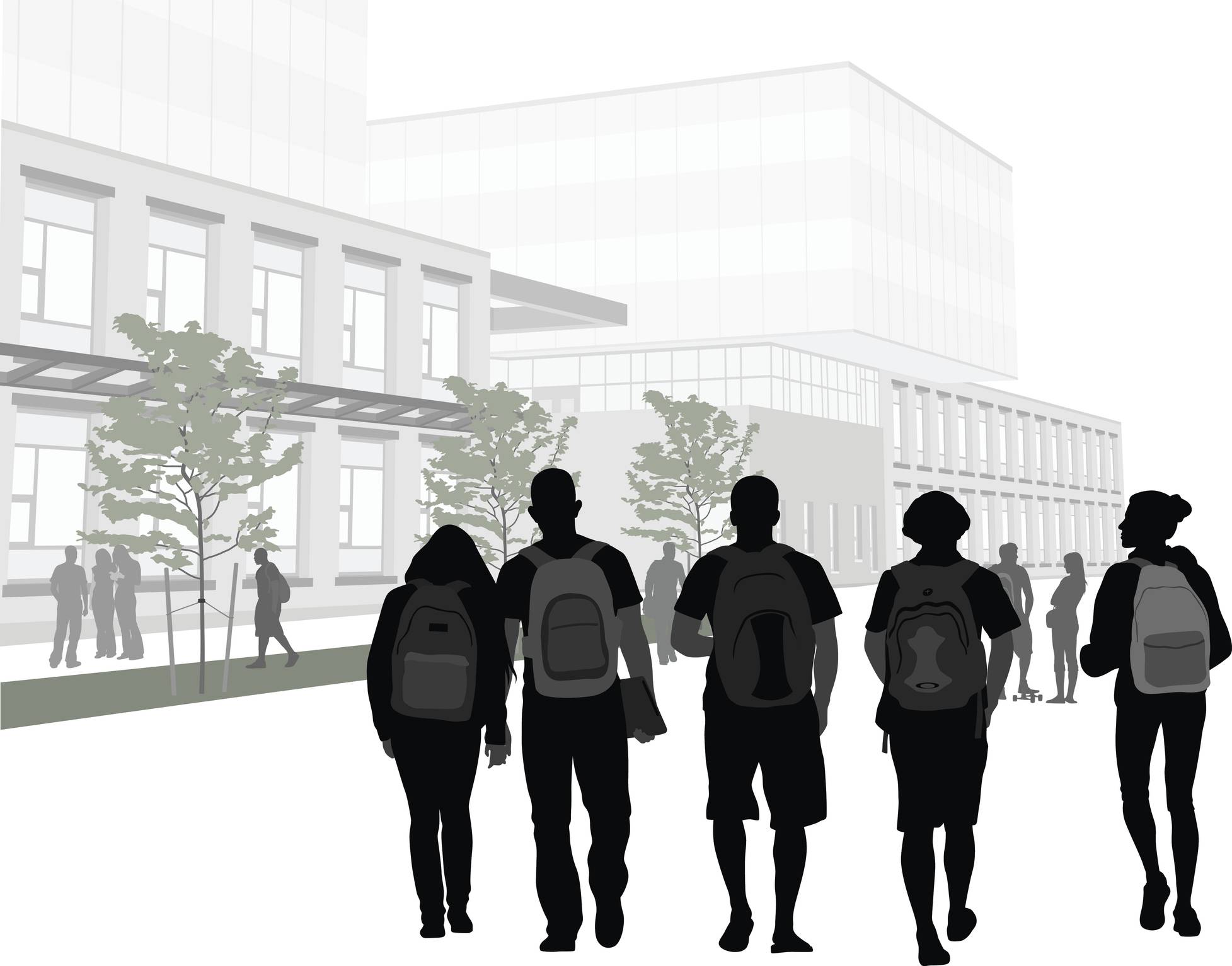
Introduction
The COVID-19 pandemic deeply disrupted global economic and social systems, imposing heavy burdens on many in the Asian region. Global supply chains were fractured and, in some cases, broken, with significant impacts on livelihoods. As countries develop and implement post-pandemic recovery strategies and seek to create buffers against future crises, the promotion of sustainable consumption and production (SCP) patterns must be a central pillar of government and corporate policies, as well as civic action. Similarly, the development of sustainable and secure systems of local resiliency must become a priority, recognising that pandemics are by no means the only crises faced by communities in the Asian region on a regular basis.
The prolonged experience of the pandemic revealed and deepened many disparities in secure access to vital products and services, especially for geographically disadvantaged nations, the economically poor, minorities, marginalised groups, and women and children. These impacts deeply impeded the ability of individuals, families, and communities to move toward realizing sustainable lifestyles and livelihoods. Reconsideration of resource and waste flows thus became a necessary exercise for many during the pandemic.
These experiences emphasise the reality that post-pandemic recovery and long-term sustainable development strategies must account for and reverse these inequities, particularly for issues such as food, waste, health, employment and other livelihood opportunities, and local resilience. These are all essential solution spaces for both human flourishing and environmental and economic sustainability and resilience. To close the access and security gaps for all and create the enabling conditions for sustainable lifestyles and livelihoods, it is therefore necessary to reconsider standard approaches to sustainable local resilience, including reliance on local, sustainably produced and managed resources. It is further necessary to reframe our thinking about crisis resilience and response to align our plans and actions with the reality that pandemics like COVID-19 are not the only crises we face. Indeed, the triple crisis of climate change, pollution, and biodiversity loss are a growing threat, as well as the recurrent economic and political shocks that cause insecurity and instability.
Institutes of higher education (IHEs) are characterised by a number of features that make them unique actors in the SCP and innovation spaces, capable of playing a key role in such efforts.
To begin, the internal and external governance structures of IHEs, and particularly universities (including varying degrees of autonomy from local, state, and national governments), provides a degree of autonomy that allows for experimentation, exploration, and the investigator-driven pursuit of knowledge. This autonomy results in IHEs ability to innovate within their own structures, take risks, and engage in activities and with partners that other stakeholders are not capable of. Indeed, IHEs have a long-standing public and private mandate to sustain knowledge transmission and generation across generations. The experience of various crises throughout history and across locations demonstrates that the combination of this mandate and governance structure lends itself to innovation in times of crisis, with inter- and intra-disciplinary developments pushing technological revolutions and context specific innovations.
Institutes of higher education are also uniquely capable of attracting, generating, mobilising, and maintaining a wide range of capital from within the institution and from across the various networks that IHEs convene. Many forms of capital are represented, including the standard four economic capitals: physical, financial, natural capital, and human capital. IHEs are able to stretch beyond this private sector model to include what are termed ‘community capital’, which includes less tangible but no less impactful resources that can be leveraged to move the dial on SCP, particular with regard to innovation, sustainable lifestyles, communications, and behaviour change. These types of capital include cultural, social, political, and built capital. IHEs are capable of channelling these various forms of capital in ways not easily available to other actors, and thus driving innovation that emerges from the investigator-driven pursuit of knowledge and the unique governance structures of IHEs.
Finally, IHEs play a central role in convening, building, and maintaining networks of local community cohesion and trust. IHEs leverage a unique set of mechanisms to convene and build community (including the long-term building of relationships of trust and collaboration with local business and civil society actors). They are often perceived as good-faith actors in the system, less entangled with other interests or motivations. As such, they are able to convene local actors in ways that provide mutual-legitimacy between, for example, the university and business community actors. IHEs thus can play the role of neutral (if not disinterested) brokers, convening and coordinating partnerships and relationships over time to build community capital and trust over time.
All of this demonstrates that Institutes of higher education are well positioned to coordinate efforts to build local resilience across the economic and civil sectors and reduce the harmful impacts of disasters and crises on lives and livelihoods. Their ability to experiment, move quickly, mobilise a wide range of stakeholders and capital through their networks of collaborators, and strategically support risk-taking makes them unique actors in the SCP ecosystem. In these ways, IHEs can contribute significantly to local, national, and global actions to ensure that current recovery efforts result in substantive progress toward SCP and local resilience. Indeed, they can be key players in achieving models of sustainable resilience that align with the central objective of the Sustainable Development Goals to “leave no one behind”. This approach places emphasis on eradicating poverty, ending exclusion and discrimination, and reducing the vulnerabilities and inequalities that undermine human flourishing and capabilities.
With these factors in mind, there is a need to convene experts and sustainability practitioners from governments, businesses, educational institutions, and civil society to discuss the opportunity space presented by the post-pandemic recovery to build sustainable local resilience. This discussion must consider how universities can serve as experimental spaces or work with communities to create living laboratories where stakeholders can come together to solve these challenges and ensure that the costs and benefits of the recovery process and emerging post-pandemic ‘next normal’ are equitably shared across stakeholder groups and leave no one behind.
This 2-hour workshop webinar, Consumption and Resilience: The Role of Institutes of Higher Education, organised by the SWITCH-Asia SCP Facility, brought together Asian and global experts on sustainable local resilience, educational institutions, and lifestyles to exchange perspectives, experiences, and learning that can support the creation of a sustainable and resilient ‘next normal(s)’. The goal is to think together about how institutes of higher education can lead or contribute to efforts to build sustainable systems of consumption and production that are equitable, secure, resilient, and leave no one behind.
The workshop explored three key aspects of post-secondary educational institutions and the investigator-driven pursuit of knowledge that lend themselves to developing just these sorts of systems – particularly with regard to disaster/crisis preparedness, response, and resilience.
These topics included:
- The internal and external governance structures of institutes of higher education (including varying degrees of autonomy from national or local state governance);
- The capacity of institutes of higher education to attract, generate, and mobilise many types of capital (including human capital, natural capital, social and cultural capital) and to bring them to bear in ways not easily available to other actors; and
- The mechanisms through which institutes of higher education convene and build community (including the long-term building of relationships of trust and collaboration with local communities)
Five speakers joined the session:
Governance Structures
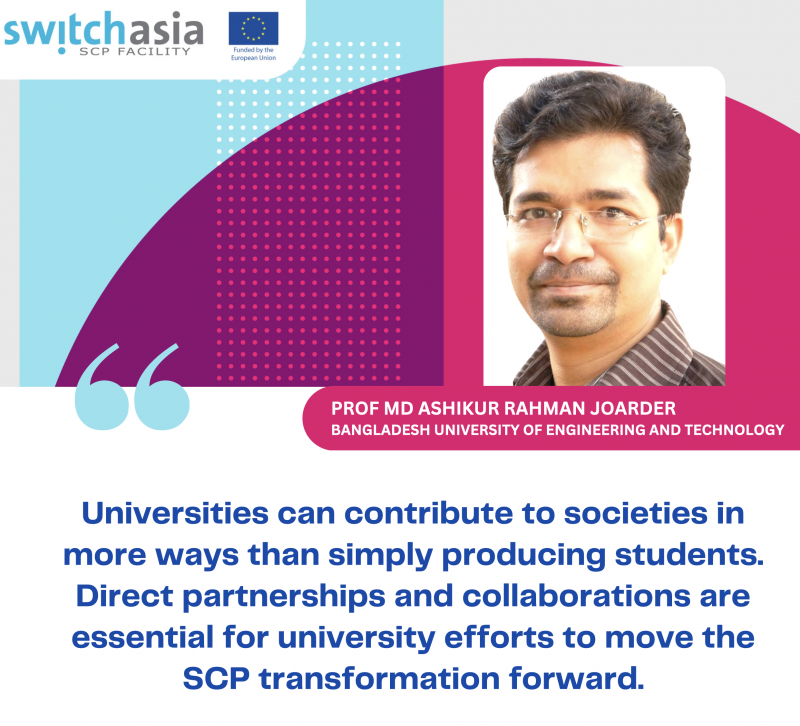 The first topic discussed by the panel was the governance and management structures of institutes of higher education. The panel discussed the challenge represented by university governance and management structures, as they have emerged over recent decades. Often, theses status quo structures stand in the way of the types of transformation needed to drive the shift to SCP. This is especially true for the market-driven assessment model as it applies to researchers and educators, and the corporate approaches to institutional management. These approaches often interfere with efforts to implement a more dynamic, responsive, and forward-thinking model of research and education that takes into consideration the desired outcomes of sustainability.
The first topic discussed by the panel was the governance and management structures of institutes of higher education. The panel discussed the challenge represented by university governance and management structures, as they have emerged over recent decades. Often, theses status quo structures stand in the way of the types of transformation needed to drive the shift to SCP. This is especially true for the market-driven assessment model as it applies to researchers and educators, and the corporate approaches to institutional management. These approaches often interfere with efforts to implement a more dynamic, responsive, and forward-thinking model of research and education that takes into consideration the desired outcomes of sustainability.
The panel largely agreed that we have seen an increased corporatisation of the university structure around the world. This has come with a shift in institutional investment toward technical departments (e.g., business schools, engineering, the hard sciences) and a disinvestment in the social sciences and humanities. This presents a challenge for the SCP transformation since the complex and interconnected problems of climate change, overconsumption, and environmental degradation are not just technical problems. Critically, these are also cultural and social problems that require us to have a good understanding of philosophy, language, cultural values, and so on to arrive at effective solutions. Indeed, these challenges seem to require a deeply interdisciplinary approach that includes contributions from the liberal arts, humanities, sciences and applied sciences.
Related to this shift away from the social sciences and humanities, the panellists also raised the central importance of effective communication on the part of IHEs to enhance impact, increase reach, and to strengthen bonds of collaboration and partnership. Such communications appear to be most effective when they are informed by a social sciences and humanities perspective that is more sensitive to audience, context, and language than a purely technical approach. Transferring knowledge and information to the larger public requires a deeper knowledge of the values, hopes, and capacities of people, as well as the effectiveness of behaviour change.
The entrenchment of the corporate university, complete with the compartmentalisation of roles, regression to scientific management approaches from the early 20th century, and an (over-) emphasis on economic impacts, poses another distinct challenge for efforts to transform socio-technical systems of production and consumption. This corporate model breaks up the components of the scholarly identity (for example, researcher, instructor, administrator, etc.) in ways that are familiar from corporate governance structures, creating well-defined and discreet roles for individuals and departments, a harder boundary between university and community, and making collaboration and ‘cross-pollination’ more difficult.
And yet, among some liberal arts colleges in particular, we are also seeing a reorganising of priorities and a revaluing of outputs and output channels that bring IHE activities more in line with sustainable development. This can be seen clearly in the inclusion of the sustainable development goals into university management practice and planning, including through the implementation of education for sustainable development in community and place-based research projects that weave together these different scholarly roles and result in new discoveries, new research potentials, and new relationships and communities of practice formed. Many universities and departments are also revaluing scholarly activities so that scholarly artefacts focused on sustainable development that reside outside of traditional journals (e.g., reports with international organisations, networks, and think tanks) are given value and merit equal to journal or book publications within the institution.
Finally, it became apparent that in many IHEs, the presence of key individuals as allies or champions of transformation was crucial for shifting governance and management practices within universities. In the absence of wide-spread, coordinated, institution-wide transformation, the efforts of well-placed individuals who have a clear vision and mission aligned with SCP transformation has proven to be somewhat effective. These limited successes should serve as demonstrations and pilots for other departments, campuses, and institutions. It is hoped that these instances can inspire broader action and uptake of new models of governance across IHEs.
Mobilising Capital in Support of SCP Transformation
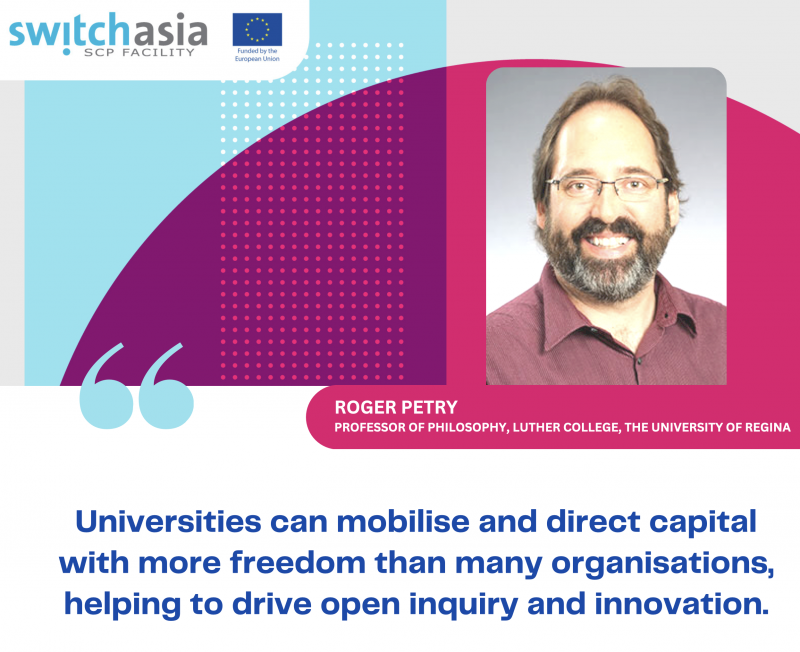 The second area considered by the panel was the distinctive ability of institutes of higher education to attract, generate, mobilize and maintain a wide range of resources or capitals. As traditionally self-governing institutions, universities are able to mobilize and direct capital with greater independence than most. In a way, a campus is its own community, not unlike a town acting as its own nexus of consumption and production that can be experimented with. Universities traditionally have had a sharing economy, with scholars pooling resources in libraries. The models of resource sharing developed internally can translate beyond the university to inform the larger economy and drive transformation in the socio-technical system. For example, the development of open source software, pioneered by Richard Stallman at MIT in the 1980s successfully moved into the mainstream to become the backbone of the modern digital economy.
The second area considered by the panel was the distinctive ability of institutes of higher education to attract, generate, mobilize and maintain a wide range of resources or capitals. As traditionally self-governing institutions, universities are able to mobilize and direct capital with greater independence than most. In a way, a campus is its own community, not unlike a town acting as its own nexus of consumption and production that can be experimented with. Universities traditionally have had a sharing economy, with scholars pooling resources in libraries. The models of resource sharing developed internally can translate beyond the university to inform the larger economy and drive transformation in the socio-technical system. For example, the development of open source software, pioneered by Richard Stallman at MIT in the 1980s successfully moved into the mainstream to become the backbone of the modern digital economy.
The university mandate for discovery also means it has resources in the form of human, financial, and productive capital dedicated to innovation regardless of whether industries and governments are cutting back on research and development. This human capital in particular not only can be redeployed to focus on local and regional sustainability issues but also to pioneer new forms of physical capital (think here of new scientific instrumentation and engineered technologies). Universities also collaborate with other universities for greater efficiencies in achieving these scholarly goals—an important form of social capital.
As curiosity is self-driven by individuals, the investigative culture of universities requires a high level of freedom that lends itself to reinforcing democratic principles through collegial governance, an important source of political capital. These freedoms also enable students to mobilize voluntarily to lead an impressive array of volunteer activities on campuses whether in sports, student government, or clubs and societies.
In mobilizing this abundance of capitals, universities also face challenges. With restricted resources, some universities are retrenching around more traditional scholarly specializations and outputs. This retrenchment is largely in line with the corporate management and technical focus that universities have increasingly taken on that was discussed in the previous section. Despite the imperatives to mobilize faculty and students to engage communities for sustainable development and to drive the SCP transformation, others see new models of university activity as undermining and challenging more traditional forms of scholarly output (measured in books, articles, and patented technologies) and the ability to garner financial support for these (from governments, private donors, etc.).
Universities are also faced by a general lack of deep knowledge of what SCP is and how it is relevant and imperative for IHEs to adopt as an operating principal. There is a clear need for capacity-building on this front so that university administrators have a better understanding of not just sustainable development, but of the key role IHEs can play in advancing systemic transformation. This lack of capacity, which is directly related to the corporate university governance structure discussed above, inhibits the creation of enabling policies that could allow for innovative use of capital within the university system and beyond.
Interestingly, here again, the panel emphasised the importance of storytelling; communication that centres on stakeholder values, priorities, and realities can be game changing for transformation both at the local and system levels. Key to the success of these efforts is the engagement of the university itself, the governance and management structure of the institution, that can help to set the enabling conditions for departments, faculty, and students to tune in and engage around new models. These structures need to reassess the stories they tell themselves about their role in the world, especially with regard to innovating and leading the transformation for SCP. Without the enabling environment created by governance structures, the various types of capital available to the university are less able to be mobilised and coordinated effectively. Critically, this also includes outreach and community-building between IHEs that builds relationships and spawns opportunities for collaboration and co-learning, but also for sharing resources and building a broader movement of transformation within university systems.
Convening and Building Communities and Communities of Practice
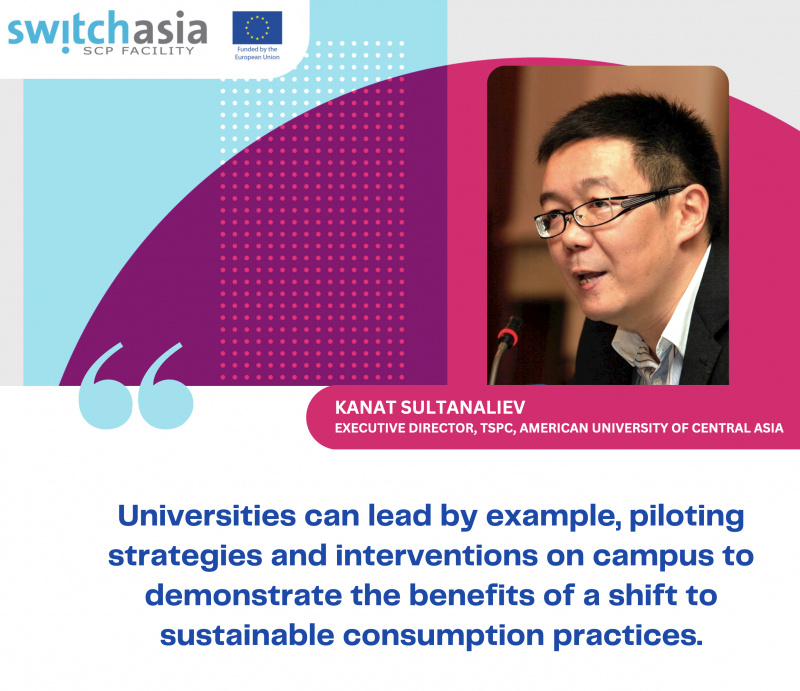 Institutes of higher education play a central role in convening, building and maintaining communities, communities of practice, and networks locally, nationally and globally. Their accountability to citizens in general over the long term (as opposed to a current government or corporate interest) allows for an impartial engagement with a large range of stakeholders. Additionally, university faculty often serve on a variety of public committees and commissions, providing their expertise when asked to do so and training leaders within the various professions. In a world of fake news and social media, IHEs also serve as honest brokers able to build trust. Why is this? A professor’s or a student’s scholarly livelihood is built on their reputation which requires following accepted scholarly methods and the evidence they produce. Unlike other occupations, fabrication of data and other evidence to support one’s views is fatal to a scholar’s career. Educational institutions are also designed for transmission of knowledge, whether in classrooms, common areas, or through traditional publications and digital platforms so universities have access to pre-existing spaces to act as conveners. An added benefit for IHEs and their partners is the patina of legitimacy and institutional weight that comes from participation in these communities and collaborations. There are spill-over benefits for capital mobilisation, too. Financial capital is attracted to projects and activities where risk is shared and where multiple streams of funding are already in place. In short, capital attracts capital, and communities of practice and interest are highly effective means of attracting many forms of capital from human to social, physical, and financial.
Institutes of higher education play a central role in convening, building and maintaining communities, communities of practice, and networks locally, nationally and globally. Their accountability to citizens in general over the long term (as opposed to a current government or corporate interest) allows for an impartial engagement with a large range of stakeholders. Additionally, university faculty often serve on a variety of public committees and commissions, providing their expertise when asked to do so and training leaders within the various professions. In a world of fake news and social media, IHEs also serve as honest brokers able to build trust. Why is this? A professor’s or a student’s scholarly livelihood is built on their reputation which requires following accepted scholarly methods and the evidence they produce. Unlike other occupations, fabrication of data and other evidence to support one’s views is fatal to a scholar’s career. Educational institutions are also designed for transmission of knowledge, whether in classrooms, common areas, or through traditional publications and digital platforms so universities have access to pre-existing spaces to act as conveners. An added benefit for IHEs and their partners is the patina of legitimacy and institutional weight that comes from participation in these communities and collaborations. There are spill-over benefits for capital mobilisation, too. Financial capital is attracted to projects and activities where risk is shared and where multiple streams of funding are already in place. In short, capital attracts capital, and communities of practice and interest are highly effective means of attracting many forms of capital from human to social, physical, and financial.
Yet despite this potential, IHEs also face challenges engaging communities. Many professors and students come from elsewhere and are not connected to the local community in which their university is situated. This leaves them unaware of the local and regional problems to which their expertise might be put. Scholars may also be reluctant to speak in a public environment that does not appreciate the rational standards and methods employed within universities. Many of the historic advances in knowledge have also occurred because academics have been in control of the process of discovery: determining the problem, choosing an appropriate way of answering the problem, and designing experiments and technologies under controlled conditions. The sustainability problems facing communities, however, are complex and interrelated occurring under conditions of rapid change and uncertainty. This requires professors and students to let go of tightly controlled processes and, instead, empower community members to be scholars in their own right with traditional academics acting as facilitators and participants.
Emergent Topics
The panel discussion was wide-ranging and moved beyond these guiding themes. From this open discussion a number of key insights emerged that do not neatly fit into the preceding themes. Many of the following points are reflective of the larger debate that is currently taking place within IHEs around the world and highlight some of the central challenges and opportunities that universities face.
Challenging the Status Quo
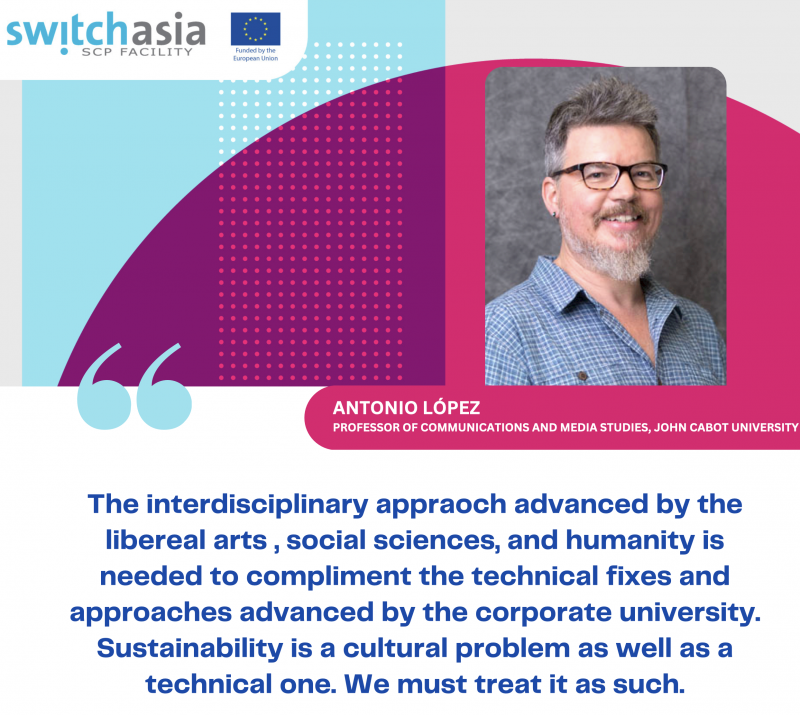 It is important for IHEs, including departments and scholars, to carefully examine their own implicit bias by thinking critically about what the status quo is, what it represents, and to what extent educational systems are embedded in it. The status quo at is currently exists is underwritten by the global fossil fuel industry that powers the economy, mobility, and creates the plastics we rely on for daily life. This status quo, and the extent to which IHEs are embedded within it, including reliance on it for funding, may be one of the biggest inhibitors to change. IHEs need to be willing to deeply interrogate the status quo and their position in it and to question honestly the extent to which they are really willing to engage in transformative change.
It is important for IHEs, including departments and scholars, to carefully examine their own implicit bias by thinking critically about what the status quo is, what it represents, and to what extent educational systems are embedded in it. The status quo at is currently exists is underwritten by the global fossil fuel industry that powers the economy, mobility, and creates the plastics we rely on for daily life. This status quo, and the extent to which IHEs are embedded within it, including reliance on it for funding, may be one of the biggest inhibitors to change. IHEs need to be willing to deeply interrogate the status quo and their position in it and to question honestly the extent to which they are really willing to engage in transformative change.
Innovating for Transformative Technologies
Institutes of higher education would do well to recall the lessons of history with regard to innovation and system-wide transformation. Often it is the introduction of one or two key, transformative technologies that drive change. These technologies and the processes of change they spark, force people to change in order to succeed in the new dynamic. For example, the introduction of money made it so people no longer needed to accumulate a large volume of goods in order to store value. It completely transformed the economic system. Similarly, open source software changed everything. A university-based model of sharing productive equipment both within the campus and more broadly with the community could really change the system so that, again, the drive to accumulate more and more goods is short-circuited.
Building Community Capacity
Professors and researchers enjoy some degree of freedom related to their research activities – subjects, questions, methods, etc. It is essential that these individuals and teams take forward into their work, especially project-based work, a new model that blends traditional research with education / capacity building for partners, as well as deeper engagement with stakeholders and the broader community. This type of approach holds the potential for broadening the coalition driving the SCP transformation and building capacity across society beyond the boarders of traditionally framed research projects.
Building IHE Capacity
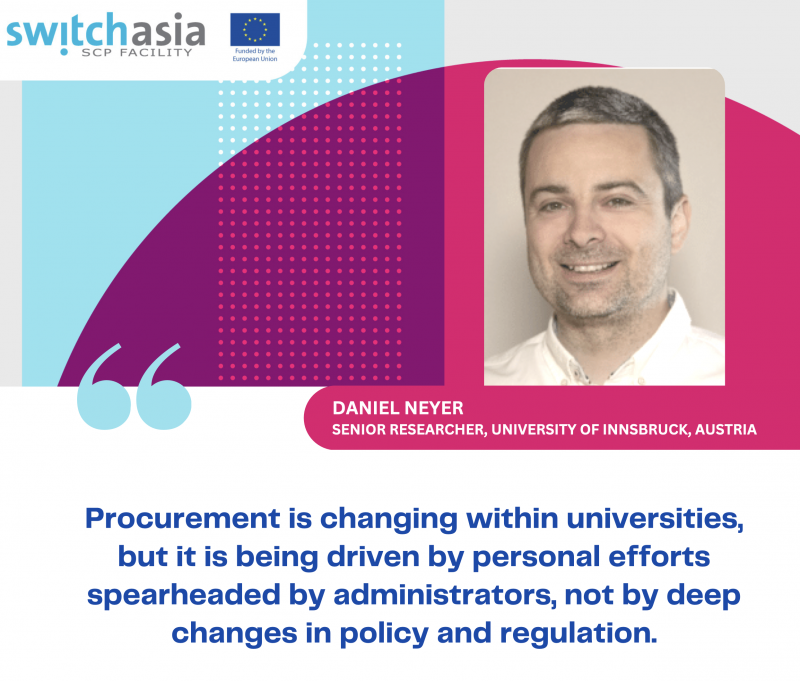 Universities are at the forefront of knowledge dissemination; however, sometimes universities themselves need help in learning and building capacity around emerging practice. The SCP topic, for many universities, is relatively new. While many IHEs are willing and interested to include SCP in their activities – across campuses, in classrooms, and in research projects – there is a lack of learning and training materials to build their capacity. Universities need to take the time and effort to invest in building their own capacity around SCP so that they can effectively transfer knowledge through their networks that will drive the SCP transformation.
Universities are at the forefront of knowledge dissemination; however, sometimes universities themselves need help in learning and building capacity around emerging practice. The SCP topic, for many universities, is relatively new. While many IHEs are willing and interested to include SCP in their activities – across campuses, in classrooms, and in research projects – there is a lack of learning and training materials to build their capacity. Universities need to take the time and effort to invest in building their own capacity around SCP so that they can effectively transfer knowledge through their networks that will drive the SCP transformation.
Taking Risks
In more institutes of higher education, risk-taking is largely undertaken by individual researchers, teams, or labs, rather than by the institution itself. IHEs can increase their influence and impact by engaging adopting a risk-taking attitude behind their actions. Such a shift in the university’s tolerance for risk-taking can drive innovation and adoption of disruptive models and practices.
Acknowledgment
This article was written by Dwayne Appleby, Institute for Global Environmental Strategies (IGES) in coordination with Zinaida Fadeeva, SWITCH-Asia SCP Facility. It was produced within the context of the organisation of the webinar entitled Consumption and Resilience: The Role of Institutes of Higher Education that took place on 27 October 2022 and which brought together Asian and global experts on sustainable local resilience, educational institutions, and lifestyles to exchange perspectives, experiences, and learning that can support the creation of a sustainable and resilient ‘next normal(s)’.




